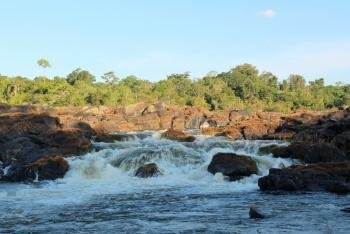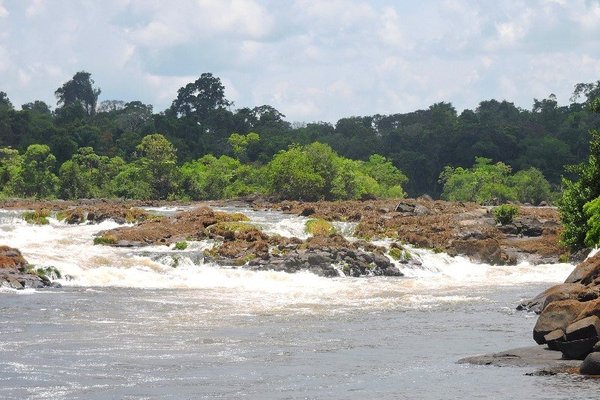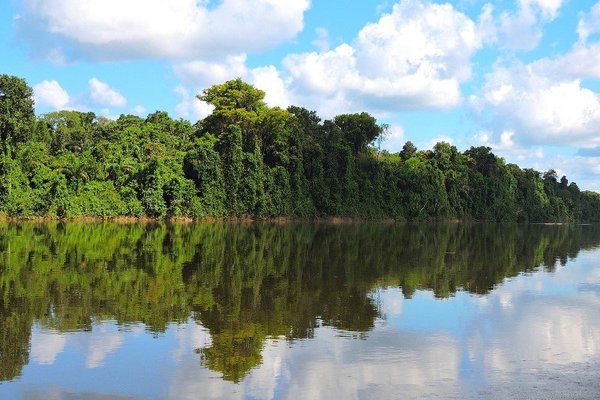Suriname
Central Suriname Nature Reserve
The Central Suriname Nature Reserve covers an immense area of pristine tropical forest in the Guayana Shield.
The reserve is one of the very few undisturbed forest areas left in the Amazonian region with no inhabitants and no human use. Located at the upper watershed of the Coppename River, it contains areas of swamp forest and savannah. Typical granite inselbergs rise above the forest canopy. Globally rare fauna species found here include the Cock-of-the Rock, the Harpy Eagle, Jaguar, Giant Armadillo and Giant Otter.
Community Perspective: The reserve is serviced by organized multi-day tours from Paramaribo – a more independent visit will be tough. Geert and Michael each have described such a tour. Finding the wildlife in such a vast area isn’t easy, but Michael made the extra effort to see the cool Guianan Cock-of-the-Rocks.
Site Info
Official Information
- Full Name
- Central Suriname Nature Reserve (ID: 1017)
- Country
- Suriname
- Status
-
Inscribed 2000
Site history
History of Central Suriname Nature Reserve
- 2000: Inscribed
- Inscribed
- Type
- Natural
- Criteria
- ix
- x
Links
- UNESCO
- whc.unesco.org
All Links
UNESCO.org
- whc.unesco.org — whc.unesco.org/
Community Information
- Community Category
- Natural landscape: Forest
Travel Information
Recent Connections
-
World Heritage Forest Programme
-
Plant WHS not in a CPD
"The site contains a stunning diversity… -
Petroglyphs
These statements ignore the fact that t…
Connections of Central Suriname Nature Reserve
- Geography
-
-
Situated in one of the SIDS
Suriname 2000 -
Territorial Highest points
Julianatop, at 1280m the highest peak in Suriname
-
- Trivia
-
-
Covers more than 5 percent of country
Covers 9,8% of Suriname
-
- Ecology
-
-
Jaguar habitat
-
Rainforests
-
Otters
Giant River Otter -
Granite rock formations
Granite domes, mentioned by IUCN as one of the 5 distinguishing factors of this nature reserve -
Inselbergs
Voltzberg Dome -
Sloths
pale-throated sloth, two-toed sloth -
Anteaters
giant anteater, silky anteater, southern tamandua -
Refugium
"The CSNR conserves a large portion of the easternmost portion of the Guyana Shield, an ancient, mineral-dense layer of the earth’s crust, formerly connected to the continent of Africa. As a geologically stable speciation centre, this region has produced a well-defined assemblage of biota including many endemics. The area of the reserve falls within one of 26 Amazonia refugia as defined in Prance and Lovejoy (1985)." (IUCN) -
Table Mountain
Tafelberg -
Tapirs
Brazilian tapir -
High-Biodiversity Wilderness Area
Amazonia -
Swamps and Marshes
"areas of swamp forest" (OUV) -
Eagles
Harpy Eagle (Official description) -
Over 300 bird species
400 recorded bird species (OUV) -
Over 100 mammal species
200 mammals (UNEP-WCMC)
-
- World Heritage Process
-
-
First inscriptions
Suriname 2000 -
Perfect Inscriptions
2000
-
- Human Activity
-
-
Petroglyphs
These statements ignore the fact that the CSNR, or at least parts of it, have been occupied and used by both indigenous and tribal peoples for a variety of purposes and that there is additional archaeological evidence of traditional occupation, including cultural heritage sites such as petroglyphs. - WHS and Indigenous Peoples Rights
-
- WHS on Other Lists
-
-
Plant WHS not in a CPD
"The site contains a stunning diversity of plant and animal species, many of which are endemic to the Guiana Shield and globally vulnerable, threatened or endangered. Some 6,000 plant species have been recorded in yet incomplete inventories." (OUV) -
World Heritage Forest Programme
-
News
No news.
Community Reviews
Show full reviews
Visit in September 2019
As of this writing, there is still only one realistic way to visit this isolated rainforest site. Organized tours to natural sites are often not my preferred choice because my interests are usually focused on observing and photographing flora and fauna, especially birds. Tours offered to the general public frequently consist of a series of programed activities that take too much time away from those goals, and may also be quite crowded. Consequently, I tried to search for another route to the site that would let me see the forest in a more independent way. There were one or two sites on the Web that describe journeys to the southernmost of the three national parks that were combined and expanded when the site was inscribed. However, those were more like true wilderness expeditions, lasting around two weeks, and that would not have been practical during my current trip. Since I wanted to see the site, I relented, and signed up for one of the commercial tours that depart from Paramaribo and visit Raleighvallen National Park, at the northern end of the inscribed site. As it turned out, that worked out quite well for me in this case.
The standard tours last four days, two of which are mostly consumed by travel to and from the park. The trip from Paramaribo involves a one and a half hour bus ride on paved roads, another two and a half on a long dirt road, and then …
Keep reading 0 comments
Although I am a long time member of worldheritagesite.org, till now I never wrote a review, mainly because most sites are already excellently covered by others. But to my surprise nobody wrote about the Central Suriname Nature reserve. To my surprise, because although the site isn't reached easily, still a lot of people seem to make it there.
By far the easiest way to visit is on an organised tour from the capital Paramaribo. First you go by minibus to the Kwinti village of Witagron. The bauxite road is not too bad and it takes about 4 hours to get there. From Witagron you continue by boat. In the dry season this is not so easy as water levels can be very low, which means many times getting out of the boat into the water and pushing it forward. Although piranha's, cayman and electric eels live here nobody seems to worry a lot about them.
Be prepared for loud music in the boat.
After a trip of nearly 5 hours we reached the lodge which is on an island in the nature reserve. Accomodation is rather basic, mainly hammocks, but also a few en suite bedrooms. Most visitors are Dutch stagiaires, who are mainly interested in music and dancing, swimming in the rivers and waterfalls and not so much in experiencing the pristine rain forest. This influences the atmosphere and makes the experience less agreable than it could be. Excursions are to the Raleigh falls and a long walk to …
Keep reading 0 comments

